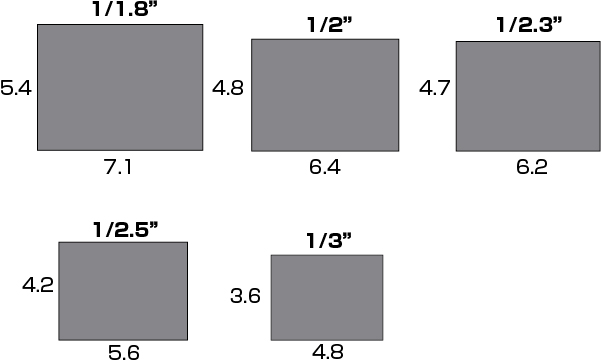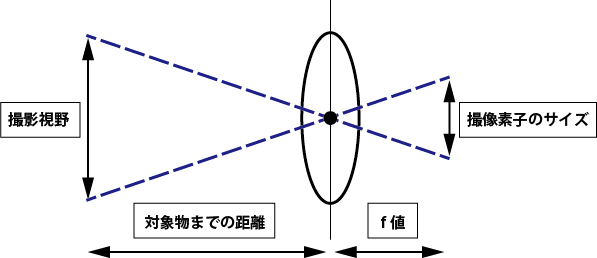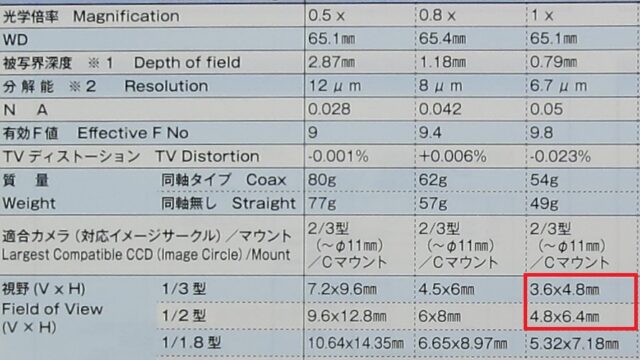How to use the image sensor size?
When using the same lens, the smaller the size of the image sensor, the narrower the field of view. In addition, the size of the image sensor is a necessary factor in the calculation of the field of view and the selection of the lens. (More on this later.)
The size of a single pixel can also be calculated from the size of the image sensor
For example, if the image sensor size of 1.3 million pixels (1280 dots × 1024 dots) is 1/2.5 inch, the horizontal orientation is 5.6 mm and the vertical direction is 4.2 mm.
In this case
Horizontal 5.6mm/1280dot=0.0044mm/dot
Vertical direction is 4.2 mm/1024 dot = 0.0041 mm/dot.
Meaning of image sensor size
Actual image sensor size
4:3 horizontal and vertical image sensor

19:6 horizontal and vertical image sensor

Actual use of image sensor size
When choosing a lens or calculating the distance to an object, the size of the image sensor is required.
(1) In the case of a CCTV lens (fixed focal length lens)
The following factors are required to calculate the required lens based on the size of the object: the size of the camera’s image sensor and the distance to the object (W.D.).

For example, if the distance to the object is 1 meter and the vertical field of view is 300 mm, what focal length lens should you choose? (Let’s assume we use a 1/2 inch camera).
The image sensor size of a 1/2 inch camera is as follows.

Focal length (f) = (distance to object (mm) x vertical size of image sensor (mm)) / vertical field of view = (1000mm x 4.8mm) / 300mm = 16mm
Therefore, choosing a lens with a focal length of 16mm will ensure the desired vertical field of view. Horizontal field of view can be calculated similarly.
Note that once you know the vertical or horizontal field of view, you can easily calculate the other field of view. A square image sensor has an aspect ratio of 4:3, so in the above case, the horizontal field of view is 300mm x 4/3 = 400mm.
(2)For macro lenses
Lenses that magnify objects often have a fixed focal length.
In this case, the characteristics of the lens cannot be expressed by the focal length (f value).
In the case of microlenses, performance is expressed in terms of optical magnification.
With a lens with an optical magnification of 1x, the field of view you want to observe matches the size of the image sensor.
For example, the size of a 1/3 inch image sensor is 4.8 mm x 3.6 mm, and the size of a 1/2 inch image sensor is 6.4 mm x 4.8 mm. We would appreciate it if you could check the specifications of our macro lenses based on this information.

<List of industrial cameras to choose from based on image sensor size>
| USB camera CS series | USB camera DN series | GigE camera | |
| 1/1.1 inch |
CS1200-GC (12 million pixels, color)/ CS1200-GB (12 million pixels, monochrome) |
EG1200-GC (12 million pixels, color)/ EG1200-GB (12 million pixels, monochrome) |
|
| 1/1.7 inch |
CS1200-C (12 million pixels, color)/ CS1200-B (12 million pixels, monochrome) |
EG1200-C (12 million pixels, color)/ EG1200-B (12 million pixels, monochrome) |
|
| 1/1.8 inch |
DN3RG-130 (1.3 million pixels, color)/ DN3RG-200 (2 million pixels, color)/ |
EG320-C (3.2 million pixels, color)/ EG320-B (3.2 million pixels, monochrome) EG600U-C (6 million pixels, color)/ EG600U-B (6 million pixels, monochrome) |
|
| 1/2.3 inch | DN3R-1000 (10 million pixels, color) | ||
| 1/2.5 inch | CS500-C (5 million pixels, color)/ CS500-B (5 million pixels, monochrome) |
DN3R-500 (5 million pixels, color) | |
| 1/2.9 inch |
CS41-C (400,000 pixels, color)/ CS41-B (400,000 pixels, monochrome) |
EG41-C (400,000 pixels, color)/ EG41-B (400,000 pixels, monochrome) |
|
| 1/2 inch |
CS130U-C (1.3 million pixels, color)/ CS130U-B (1.3 million pixels, monochrome) CS500U-GC (5 million pixels, color)/ CS500U-GB (5 million pixels, monochrome) |
EG130U-C (1.3 million pixels, color)/ EG130-B (1.3 million pixels, monochrome) |
|
| 1 inch |
CS2000-C (20 million pixels, color)/ CS2000-B (20 million pixels, monochrome) |
EG2000-C (20 million pixels, color)/ EG2000-B (20 million pixels, monochrome) |
|
| 2/3 inch |
EG501-C (5 million pixels, color)/ EG500-B (5 million pixels, monochrome) |
Summary
The size of the image sensor is information necessary for calculating the field of view and selecting a lens. For CCTV lenses, use the following formula when calculating the lens for the desired vertical field of view:
f value = (distance to object (mm) x vertical size of image sensor (mm)) / vertical field of view
For macro lenses, the size of the image sensor is used to calculate the total magnification that will ultimately be displayed on the monitor.



